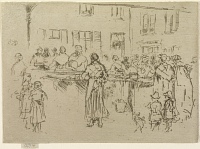Fish Women, Ostend | ||
| Number: | 349 | |
| Date: | 1887 | |
| Medium: | etching and drypoint | |
| Size: | 96 x 133 mm | |
| Signed: | butterfly at upper left | |
| Inscribed: | no | |
| Set/Publication: | no | |
| No. of States: | 2 | |
| Known impressions: | 3 | |
| Catalogues: | K.349; M.349 | |
| Impressions taken from this plate (3) | ||
KEYWORD
children, costume, dress, fish, market, people, stall, streetscape, woman standing.
TITLE
Examples of alternative titles and punctuation are as follows:
'Fish women / Ostend' (1887, Whistler). 3
'Fish Women Ostend' (1887/1888, Whistler). 4
'Fish Women' (1888, Whistler). 5
'Fish Women - Ostend' (1890/1892, Beatrice Whistler (1857-1896)). 6
'Fish market - Ostend' (1897, Wunderlich's). 7
'Fisherwomen, Ostend' (1905, ISSPG). 8
'Fish Women. Ostend' (1903/1935, possibly Rosalind Birnie Philip (1873-1958)). 9
'Fish-Market, Ostend' (1909, Howard Mansfield (1849-1938)). 10
'Fish Women, Ostend' (2011, WEP).
Thus there is a conflict, in the suggested titles, between the women and the market as dominating the subject. However, 'Fish Women, Ostend', with revised punctuation, is the earliest and preferred title.
H. Wunderlich & Co. also recorded a 'Fish-Woman - Brussels', which could possibly be this etching or Fishing Quay, Ostend [351]. 11
'Fish women / Ostend' (1887, Whistler). 3
'Fish Women Ostend' (1887/1888, Whistler). 4
'Fish Women' (1888, Whistler). 5
'Fish Women - Ostend' (1890/1892, Beatrice Whistler (1857-1896)). 6
'Fish market - Ostend' (1897, Wunderlich's). 7
'Fisherwomen, Ostend' (1905, ISSPG). 8
'Fish Women. Ostend' (1903/1935, possibly Rosalind Birnie Philip (1873-1958)). 9
'Fish-Market, Ostend' (1909, Howard Mansfield (1849-1938)). 10
'Fish Women, Ostend' (2011, WEP).
Thus there is a conflict, in the suggested titles, between the women and the market as dominating the subject. However, 'Fish Women, Ostend', with revised punctuation, is the earliest and preferred title.
H. Wunderlich & Co. also recorded a 'Fish-Woman - Brussels', which could possibly be this etching or Fishing Quay, Ostend [351]. 11
4: List, [August 1887/1888], GUW #13233.
5: Whistler to T. M. McLean, [11 February 1888], GUW #13018.
6: List, [1890/1892], GUW #12715.
7: .Wunderlich's to Whistler, [August 1897], GUW #07289.
8: London Mem. 1905 (cat. no. 374).
9: Envelope containing copper plate, Hunterian Art Gallery.
10: Mansfield 1909 (cat. no. 349).
11: 3 May 1888, GUW #07158.
DESCRIPTION
Two rows of wooden tables are set out in a covered market (a slender iron pillar and the edge of the roof are sketched at the top). In the foreground at left are two girls, and at right, a chicken and two small children. A stall holder, wearing a big apron, stands in the centre, her back to the viewer. To her right, on the table, are fish and a metal pot, and under the table, a bucket. Further right, at the next stall, are two women with white starched bonnets, wearing ample cloaks. Stall holders and customers, women wearing shawls and aprons, are standing at all the stalls. In the background is a row of two-storey buildings with open louvred shutters on some windows.
SITE
Ostend (Oostende) is a city and municipality in the Flemish province of West Flanders, 110 kms northwest of Brussels. The largest coastal city in Belgium, it was a busy fishing port and terminal for the ferries from Ramsgate. Whistler etched four named Ostend subjects, Fish Market, Ostend, Fishing Quay, Ostend [351], The Canal, Ostend [352], and The Beach, Ostend [353].
A famous fish market (Vistrap) is held on the fishing quay (Visserskaai) on the sea front.
The market in Whistler's etching, close to the quay, is no longer in existence. It was an iron-framed building with glass roof, that is just visible at the top of the plate. The pots on the tables may have contained local specialities, such as mussels or young herring (maatjesharing) and the tables, fish fresh from the North Sea - sole and plaice. It is almost certainly the same site seen in Market Place, Ostend [350].
DISCUSSION
Several of the women are wearing distinctive local dress. Belgian lace adorned costumes for high days and holidays, but everyday costume was more restrained. Some of these women are wearing local costume, with close-fitting white muslin bonnets, which may be tied under the chin, gathered at the nape of the neck and broadening behind into a little frill, or with little flaps extending at the sides, starched to stand out. A shawl, crossed over a close-fitting bodice, and held by a massive apron over a full skirt gathered at the waist, completed the outfit.


